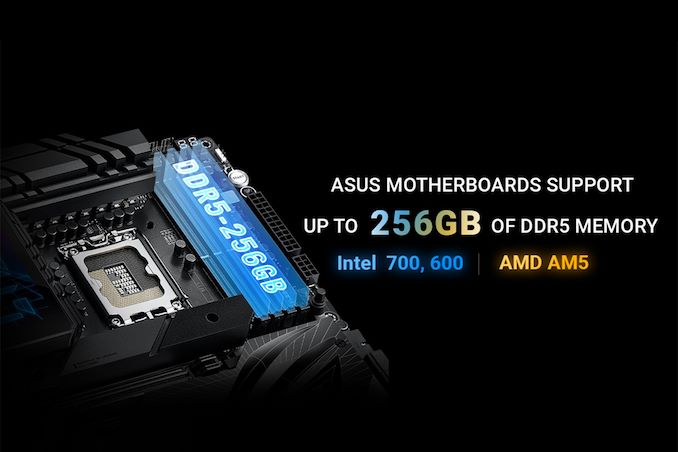Asus on Thursday said it has released new versions of UEFI BIOS for DDR5-supporting Intel 600/700-series motherboards that enable support for 64 GB DIMMs. As a result, Asus’s latest platforms for Intel’s 12th, 13th and 14th Generation Core processors with four slots for DIMM slots can now work with up to 256 GB of DDR5 memory, and motherboards with two DIMM slots can now support up to 128 GB of memory.
To gain support for 256 GB of DDR5 memory using 64 GB unbuffered DIMMs, one needs to download the latest version of UEFI BIOS for one of the Intel 600/700-series motherboards listed at the Asus website.
The list of Asus motherboards with an LGA1700 socket supporting 256 GB of DDR5 memory includes 75 boards based on a variety of Intel’s 600 and 700-series chipsets, including Intel Z790, H770, B760, Z690, W680, and Q670. Though taking stock of Asus’s larger motherboard offerings, this is still a bit shy of covering all of Asus’s LGA1700 motherboards, which is nearly 200 models in total. So 64 GB DIMM support has only come to a fraction of their boards, at least thus far.
Otherwise, it is noteworthy that cutting-edge high-capacity DIMMs, such as 32 GB, 48GB, and 64 GB, are typically not available with the same blistering XMP clockspeeds as some of their lower-capacity counterparts, so equipping an Intel system with 256 GB of memory will come at a cost of peak memory bandwidth, on top of the typical DDR5 2 DIMM Per Channel (2DPC) frequency penalty. In fact, the fastest 48 GB modules currently offered by Corsair and G.Skill (which could be used to build systems with 192 GB of memory) top out at 6600 MT/s and 6800 MT/s, respectively. Meanwhile, for now, there are no Intel XMP 3.0-compatible 64 GB DDR5 modules from these two renowned makers.
Ultimately, the prime market for high-capacity UDIMMs at this time is going to be content creators, data scientists, and other workstation-light workloads that need a quarter-terabyte of RAM, and can justify the cost for the leading-edge DIMMs. Otherwise 16 GB and 32 GB DIMMs are likely to remain the sweet spot for the LGA1700 platform for the rest of its lifecycle.
Finally, it should be noted that Asus is also announcing (or rather, reiterating) support for 64 GB DIMMs on their AM5 motherboards. That said, this support is already baked into that platform and BIOSes, and unlike the Intel boards, a BIOS update is not needed.





